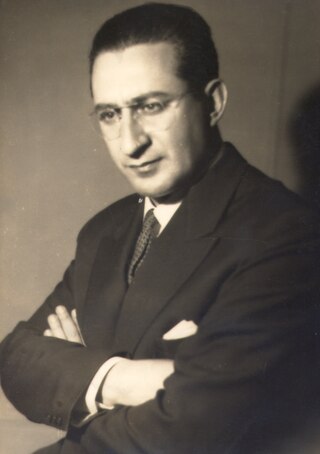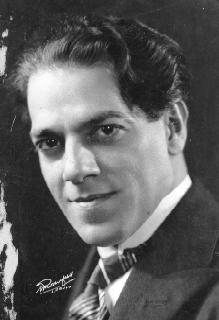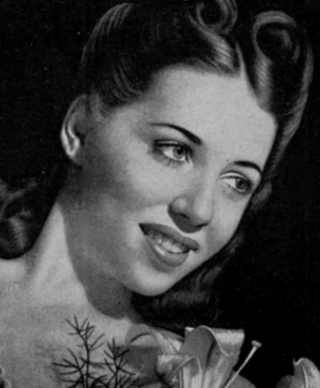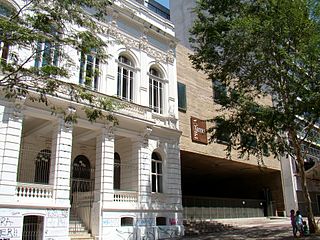Dalal Achcar | |
|---|---|
| Born | |
| Nationality | Brazilian |
| Occupation(s) | Ballet master choreographer Artistic director Theatrical producer |
Dalal Achcar is a Brazilian ballet master, choreographer, [1] artistic director and producer.
Dalal Achcar | |
|---|---|
| Born | |
| Nationality | Brazilian |
| Occupation(s) | Ballet master choreographer Artistic director Theatrical producer |
Dalal Achcar is a Brazilian ballet master, choreographer, [1] artistic director and producer.
Achcar was born in Rio de Janeiro, Brazil to Lebanese parents.
In the 1960s Achcar was the head of the Rio de Janeiro Ballet Association. [2] [3] She presented ninety shows in European capitals using music by Heitor Villa-Lobos and Cláudio Santoro, and contributions from Manuel Bandeira, Vinícius de Moraes, Di Cavalcanti and Burle Marx.
In 1962 Achcar founded, with Maria Augusta Morgenroth, the Ballet School of the Castro Alves Theater in Salvador. [4] [ failed verification ] In 1968 this school developed into the Brazilian Ballet of Bahia, of which she became artistic director. She introduced the Royal Academy of Dance method in dance teaching throughout the country, guiding schools and academies.
In 1967, Achcar arranged performances of ballet dancers Margot Fonteyn and Rudolf Nureyev at the Maracanãzinho gymnasium to popularise ballet in Brazil. [5] [6]
In 1971 Achcar, with Maria Luisa Noronha, opened the Centro de Arte e Cultura Ballet Dalal Achcar, a school delivering ballet instruction to children and professionals, offering guidance in technical and artistic training for instructors, and maintaining an assistance program in the area of dance for needy children and teenagers in risky areas. [7]
Achcar created the first higher dance professors training course in Brazil, at the Faculdade da Cidade (now UniverCidade) in Rio de Janeiro.
In the 1980s Achcar produced Brazilian classics, creating Floresta Amazônica (Amazon Forest) [8] [9] on Heitor Villa-Lobos music and featuring Gabriela, with author Jorge Amado, Caribé, Edu Lobo and choreographer Gilberto Motta.
In 1986 Achcar organised the II International Dance Festival in Rio de Janeiro and lectured on "The Latin American Ballet and its Development" at the II Latin American Conference of Experts on Ballet, in Caracas.
She was the artistic Director of the Ballet do Theatro Municipal do Rio de Janeiro, and twice president of the Fundação Theatro Municipal. [4] She arranged the first performances in Brazil of international companies, including the Royal Ballet, the Ballet de l´Opéra de Paris, and the American Ballet Theatre. She founded the Association of Friends of Teatro Municipal, and developed the ´Education with Art` program at the Municipal, with music, opera and ballet performances accompanied by teaching materials; the performances were seen by thousands of students from Rio de Janeiro schools. She organised dance shows in the city parks to introduce the mass public to ballet. In association with Funarte, she inaugurated the Memory Series, preparing biographies of artists that made up the history of music, opera and dance at the Theatro Municipal; As of 2013 [update] fifty books have been published.
In 2003 Achcar created the Companhia Jovem El Paso, which premiered in 2004 the show Superbacana: Dançando a Tropicália. Later the company changed its name to Companhia Jovem de Ballet do Rio de Janeiro. The company performs at the Theatro Municipal do Rio de Janeiro and tours Brazil with new dances by choreographers Eric Frederic, Vassili Sulich and Luis Arrieta.
Achcar developed several other choreographic works, among which are The Nutcracker , [10] Don Quijote , Abelard and Heloise, and Something Special, staged in several international centers such as Los Angeles, San Francisco, New York, Hamburg, Stuttgart, Tokyo, La Habana and Santiago de Chile, with artists such as Natalia Makarova, Marcia Haydée and Fernando Bujones.
She has published several articles and books, among which are: Jornal da Dança (1972), Ballet – Arte, Técnica e Interpretação (A technical and didactic book – 1979), Ballet – Uma Arte, (1998), A Cultura no Terceiro Mundo – ABL (1999) and Istanbul – A Fascinating City (Guide of Istanbul, 2011)
Appointed by the Brazilian Dance Council official representative of Brazil at the UNESCO Conseil International de la Dance
In 2014 Achcar is a member of the council and vice-president of the Iberian-American Association of Dance Specialists, a body connected to the Organization of American States (OAS), and is a member of the Executive and Artistic Committee of the Royal Academy of Dance.
Achcar is the widow of federal deputy Luiz Fernando Bocayuva Cunha with whom she had a son.[ citation needed ] She is the first cousin once removed of the author Nassim Nicholas Taleb.

Deborah Colker is a Brazilian writer, theater director, dancer and choreographer. She was an awardee of the Laurence Olivier Award for Outstanding Achievement in Dance. Colker was also the movement director and choreographer of the 2016 Summer Olympics opening ceremony.

Zélia Gattai Amado de Faria was a Brazilian photographer, memoirist, novelist and author of children's literature, as well as a member of the Brazilian Academy of Letters. Gattai wrote 14 different literary works, including children's books and her own personal memoirs have been widely published.

Bruno Beltrão is a Brazilian choreographer for integrating urban dance styles with conceptual theater. Since founding Grupo de Rua (GRN) in 1996, in 1996, Beltrão has explored abstract choreographic forms while transforming traditional hip hop movements.

Mozart Camargo Guarnieri was a Brazilian composer.

The Theatro Municipal is an opera house in the Centro district of Rio de Janeiro, Brazil. Built in the early twentieth century, it is considered to be one of the most beautiful and important theaters in the country.

Municipal Theatre of São Paulo is a theatre in São Paulo, Brazil. It is regarded as one of the landmarks of the city, significant both for its architectural value as well as for its historical importance, having been the venue for the Week of Modern Art in 1922, which revolutionised the arts in Brazil. The building now houses the São Paulo Municipal Symphonic Orchestra, the Coral Lírico and the City Ballet of São Paulo.
Klauss Ribeiro Vianna was a Brazilian dancer, choreographer and theater director.
Sonia Destri Lie, often known simply as Sonia Destri, is a Brazilian dancer and choreographer. In 2005, she formed Companhia Urbana de Dança, a hip hop group, which has achieved increasing international recognition. Destri has recruited and trained dancers from Rio's favelas, whatever their social or ethnic backgrounds.

String Quartet No. 1 is the first of seventeen works in the genre by the Brazilian composer Heitor Villa-Lobos, originally written in Nova Friburgo in 1915 and extensively revised in 1946. A performance lasts approximately eighteen minutes.

String Quartet No. 3 is the third of seventeen works in the medium by the Brazilian composer Heitor Villa-Lobos, and was written in 1916. A performance lasts approximately twenty-three minutes.

String Quartet No. 7 is the seventh of seventeen works in the genre by the Brazilian composer Heitor Villa-Lobos, written in 1942. With a performance lasting approximately 37 minutes, it is the longest of Villa-Lobos's string quartets

String Quartet No. 8 is one of seventeen works in the genre by the Brazilian composer Heitor Villa-Lobos, written in 1944. A performance lasts approximately twenty-five minutes.

String Quartet No. 11 is a 1947 string quartet, part of a 17-work series in the medium by Brazilian composer Heitor Villa-Lobos. A performance lasts approximately 27 minutes.

String Quartet No. 13 is one of a series of seventeen works in the medium by the Brazilian composer Heitor Villa-Lobos, and was written in 1951. A performance of it lasts approximately twenty minutes.

String Quartet No. 16 is the penultimate of seventeen quartets by the Brazilian composer Heitor Villa-Lobos, and was written in 1955. A performance lasts approximately twenty minutes.

Symphony No. 1O Imprevisto is a composition by the Brazilian composer Heitor Villa-Lobos, written in 1916. A performance lasts about twenty-five minutes.

Madeleine Rosay born Magdalena Rosenzveig was a Brazilian ballet dancer and TV presenter.

Uirapuru is a symphonic poem or ballet by the Brazilian composer Heitor Villa-Lobos, begun as a revision of an earlier work in 1917 and completed in 1934. A recording conducted by the composer lasts 20 minutes and 33 seconds.

Mercedes Ignácia da Silva Krieger, known as Mercedes Batista or Mercedes Baptista was a Brazilian ballet dancer and choreographer, the first black woman to join Theatro Municipal do Rio de Janeiro's corps de ballet.

The São Paulo School of Dance, also known as the São Paulo Municipal Theater Dance School or the Municipal Ballet School, is located in the Brazilian city of São Paulo. It is linked to the training center of the São Paulo Municipal Theater Foundation.